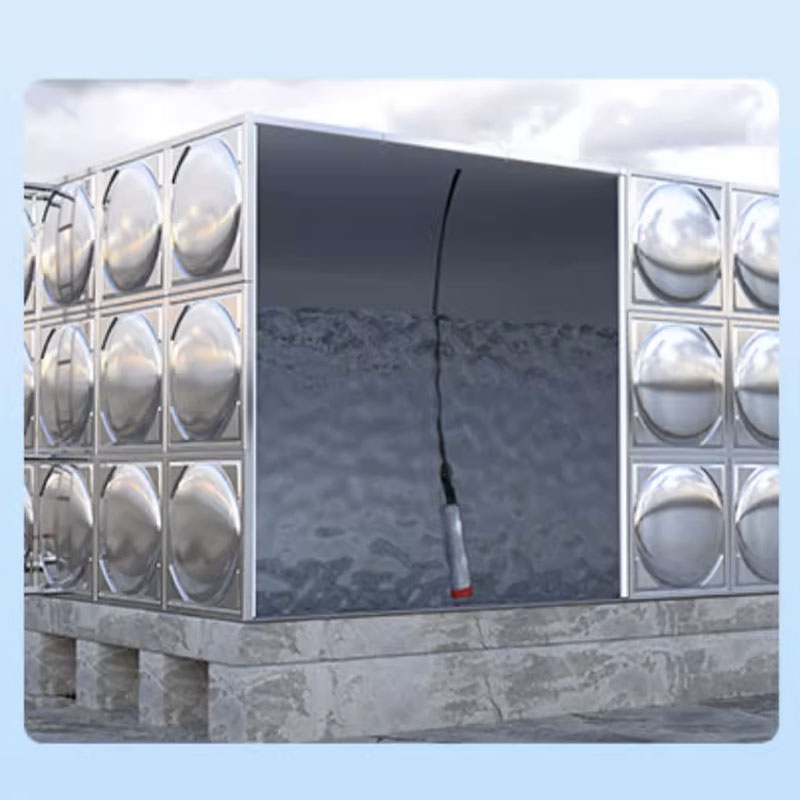Liquid level measurement is a crucial task in many fields such as industrial production, water monitoring, and environmental engineering.
Whether monitoring the water level of the water tower or controlling the liquid inventory in the chemical storage tank, reliable liquid level measurement equipment is indispensable.
The input type liquid level gauge has become the preferred choice in many industries due to its unique design and excellent performance.
The working principle of the input level gauge is based on Pascal’s law in fluid statics.
When the sensor probe of the liquid level gauge is immersed in liquid, according to the formula \ (P=ρ gh ) (where \ (P ) is the liquid pressure\ (ρ ) is the density of the liquid\ (g ) is the acceleration due to gravity\ (h ) is the liquid level height, and the probe will be subjected to static pressure proportional to the depth of the liquid level.

The pressure-sensitive components inside the sensor undergo slight deformation under pressure, causing a change in resistance value.
The resistance change is converted into a voltage signal through a Wheatstone bridge. The weak voltage signal is amplified, filtered, and converted into a digital signal by an analog-to-digital converter. Finally, the controller calculates the accurate liquid level height based on preset parameters.
Compared with other liquid level measuring instruments, the input type liquid level gauge has significant advantages. In terms of installation and maintenance, its installation method is extremely simple. Simply immerse the probe vertically into the liquid, connect the cable and display instrument to complete the installation, without the need for complex debugging processes.
There are no mechanical moving parts inside, greatly reducing the risk of wear and blockage. Daily maintenance is easy and worry free. In terms of measurement performance, its measurement accuracy is as high as ± 0.2% FS – ± 1% FS, with a range from tens of centimeters to tens of meters.
Whether it is a small container or a large liquid storage tank, it can accurately measure. At the same time, the liquid level gauge has a fast response speed and can quickly capture dynamic changes in liquid level. It also has excellent anti-interference ability, effectively suppressing temperature drift and electromagnetic interference, ensuring the stability and reliability of measurement data.
In addition, the cost-effectiveness of the input type liquid level gauge is also outstanding, with a simple structure, low manufacturing cost, and support for multiple standard signal outputs such as 4-20mA current signals and RS485 digital signals, making it easy to be compatible with various control systems and reducing system integration costs.
It is precisely these advantages that enable the input type liquid level gauge to shine in many fields. In industrial production, chemical enterprises use it to monitor the liquid level in reaction vessels and storage tanks in real time, ensuring the safety and stability of the production process; The food and beverage industry uses it to precisely control the liquid level of ingredient tanks, ensuring consistency in product quality.
In the field of water conservancy monitoring, input level gauges are widely used for water level monitoring of rivers, reservoirs, and wells, providing key data support for flood prevention, drought resistance, and water resource allocation. In environmental engineering, it can monitor the liquid level of sewage in the sewage treatment tank in real time, help optimize the sewage treatment process, and improve treatment efficiency.
In the civilian field, the secondary water supply system in residential areas monitors the water level of the water tank through an input type liquid level gauge to ensure stable water supply for residents.
With the continuous advancement of technology, the input type liquid level gauge is also continuously developing. On the one hand, the innovation of sensor technology has further improved its measurement accuracy, while reducing power consumption and extending its service life; On the other hand, intelligence has become a new development trend.
The input type liquid level gauge integrated with the Internet of Things module can achieve remote data transmission and cloud analysis, making it convenient for management personnel to grasp liquid level data in real time and make intelligent decisions.
In addition, for special application scenarios such as extreme environments such as high temperature, high pressure, and strong corrosion, the application of new materials and processes makes the immersion level gauge more adaptable.
The input type liquid level gauge occupies a pivotal position in the field of liquid level measurement due to its scientific principles, significant advantages, wide applications, and bright development prospects.
In the future, it will continue to innovate and upgrade, contributing more to liquid level measurement and automation control in various industries.
